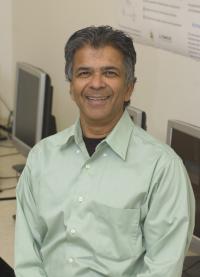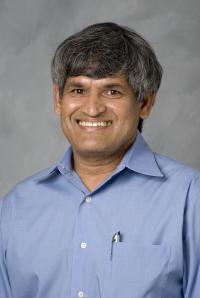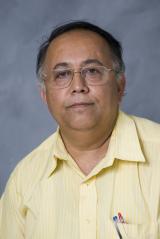 In the old days, computers were massive machines, and it took an army of programmers to keep them running. Because these older machines are very reliable and fast, however, demand declined over time for professionals trained in the technology.
In the old days, computers were massive machines, and it took an army of programmers to keep them running. Because these older machines are very reliable and fast, however, demand declined over time for professionals trained in the technology.
Flash forward 40 or 50 years, and today even microcomputers are giving way to mobile computing on smartphones and tablets. Nonetheless, some things haven’t changed: major corporations still need large, powerful mainframes capable of running thousands of transactions a minute, whether it’s to make sure the corner ATM is operational and your account is protected from fraud, or to allow you to buy airline tickets online or complete an insurance transaction.
“And the tide has turned now,” says Shan Barkataki, professor of computer science “So few universities teach mainframe technologies that now there is a big demand for students so the industry can survive.”[Read more…]
Stumble |
Del.icio.us |
Reddit |
Facebook |
Digg |
Email
 Think of it as Photoshop for antenna measurement—computer augmentation of data collected to assess different aspects of antenna performance. That’s the concept behind the project proposed by Ronald Pogorzelski and Sembiam Rengarajan and recently funded by the U.S. Army. Pogorzelski, an adjunct faculty member in the Department of Electrical and Computer Engineering, and Rengarajan, a professor in the department, received a Short-Term Innovative Research (STIR) grant to develop computational methods and algorithms for post-measurement data processing.
Think of it as Photoshop for antenna measurement—computer augmentation of data collected to assess different aspects of antenna performance. That’s the concept behind the project proposed by Ronald Pogorzelski and Sembiam Rengarajan and recently funded by the U.S. Army. Pogorzelski, an adjunct faculty member in the Department of Electrical and Computer Engineering, and Rengarajan, a professor in the department, received a Short-Term Innovative Research (STIR) grant to develop computational methods and algorithms for post-measurement data processing.
The army must assess its antennas to verify that they meet specifications, and to accomplish that, it has built highly sophisticated, very costly facilities. But Pogorzelski and Rengarajan’s premise is that the capabilities of today’s computers are so much greater than those of computers 20 or so years ago that it might be more productive to collect data using more modest instruments and then process it through a computer afterward to improve the results.
“You can spend a lot of money trying to make a measurement system as nearly perfect as possible,” Pogorzelski says. “But once you buy the computer, it’s essentially free to use, so you can spend hours if need be, massaging raw data to reveal features you couldn’t otherwise see in it.” [Read more…]
Stumble |
Del.icio.us |
Reddit |
Facebook |
Digg |
Email
 Last year, Somnath Chattopadhyay, a faculty member in electrical and computer engineering, received a three-year grant from the Department of Defense Army Research Office to develop an optically controlled silicon carbide/gallium nitride–based MESFET (metal semiconductor field effect transistor). The device, which will control the actuators in an airplane’s onboard power system with UV light rather than electrically, has several advantages: the system won’t be disrupted by radiofrequency or electromagnetic fields; it will potentially lighten aircraft by 30%; and it will not be vulnerable to radiation at high altitudes or to temperature extremes, which can also interfere with signals.
Last year, Somnath Chattopadhyay, a faculty member in electrical and computer engineering, received a three-year grant from the Department of Defense Army Research Office to develop an optically controlled silicon carbide/gallium nitride–based MESFET (metal semiconductor field effect transistor). The device, which will control the actuators in an airplane’s onboard power system with UV light rather than electrically, has several advantages: the system won’t be disrupted by radiofrequency or electromagnetic fields; it will potentially lighten aircraft by 30%; and it will not be vulnerable to radiation at high altitudes or to temperature extremes, which can also interfere with signals.
In the intervening months, Chattopadhyay has determined that gallium nitride is the more promising material for the device and plans to switch over to using it exclusively for the MESFET. He hopes to acquire metal organic chemical vapor deposition (MOCVD) equipment to grow the gallium nitride in house, which will diversify research in optoelectronic and electronic devices; gallium nitride is very expensive to buy, [Read more…]
Stumble |
Del.icio.us |
Reddit |
Facebook |
Digg |
Email
Engaged faculty are effective faculty, and the College of Engineering and Computer Science is endowed with an exceptionally large number who regularly take on innovative research and curricular projects. In addition to indulging faculty members’ intellectual curiosity, these projects are advancing knowledge, enhancing teaching and providing opportunities for students to take part in research—a high-impact practice shown to promote persistence to degree.
The following pages highlight some recent CECS faculty projects spanning fields as diverse as biomedical engineering, nanotechnology, renewable energy, computer science, cybersecurity, engineering management, civil engineering, construction and advanced materials. Some are collaborations, while others are the work of the faculty member alone. What all have in common is the benefit they are providing to today’s students and the new knowledge they are creating for tomorrow’s classrooms and the world students will inherit.
Stumble |
Del.icio.us |
Reddit |
Facebook |
Digg |
Email
 In the old days, computers were massive machines, and it took an army of programmers to keep them running. Because these older machines are very reliable and fast, however, demand declined over time for professionals trained in the technology.
In the old days, computers were massive machines, and it took an army of programmers to keep them running. Because these older machines are very reliable and fast, however, demand declined over time for professionals trained in the technology.

